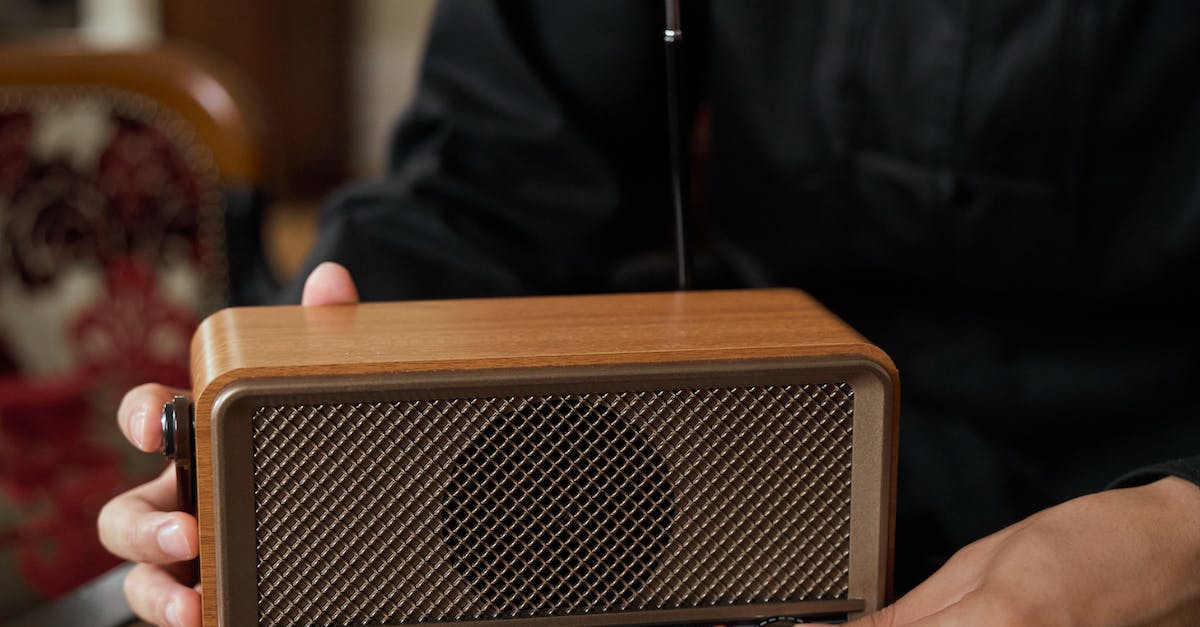Home>Devices & Equipment>Radio>How Does A Radio Wave Differ From A Sound Wave


Radio
How Does A Radio Wave Differ From A Sound Wave
Modified: March 8, 2024
Discover the key distinctions between radio waves and sound waves. Uncover how radio waves transmit information through electromagnetic waves, unlike sound waves that require a physical medium.
(Many of the links in this article redirect to a specific reviewed product. Your purchase of these products through affiliate links helps to generate commission for AudioLover.com, at no extra cost. Learn more)
Table of Contents
Introduction
A world without radio would be a dull and silent place. Radio waves, along with sound waves, form the basis of one of the most powerful methods of communication and entertainment. But have you ever wondered how radio waves differ from sound waves? In this article, we will explore the characteristics and distinctions between these two types of waves.
Radio waves and sound waves are both forms of energy that propagate through space. However, their fundamental properties and applications differ significantly. Understanding these differences can help us appreciate the marvels of radio technology and its impact on our daily lives.
Before we delve into the specifics, let’s define what radio waves and sound waves actually are. Radio waves are a type of electromagnetic radiation, while sound waves are mechanical vibrations that travel through a medium, such as air or water.
Radio waves were first discovered by James Clerk Maxwell in the 19th century, paving the way for the development of wireless communications. Sound waves, on the other hand, have been a part of human existence since our earliest ancestors communicated through basic vocalizations and gestures.
Throughout history, both radio waves and sound waves have played crucial roles in various aspects of human life. From transmitting music and news to enabling long-distance communication, radio waves have revolutionized the way we connect with the world. Similarly, sound waves allow us to communicate, perceive the environment, and experience the joys of music and entertainment.
Now that we have a brief introduction to radio waves and sound waves, let’s explore their characteristics in further detail and understand how they differ from each other.
Definition of Radio Waves
Radio waves are a type of electromagnetic radiation that carry signals through the air or space. They were first theorized by James Clerk Maxwell and later confirmed by Heinrich Hertz in the late 19th century. These waves have unique properties that enable their transmission over long distances without the need for physical connections.
Radio waves are a form of energy that oscillate at a specific frequency within the electromagnetic spectrum. They have a wide range of frequencies, from a few kilohertz (kHz) to several gigahertz (GHz). This range allows for the transmission of various types of information, including audio, video, and data.
Radio waves are generated by oscillating electric charges, which create changing magnetic fields. These fields then propagate through space, carrying the information they encode. The wavelength of a radio wave is determined by its frequency and can vary from kilometers to millimeters.
One of the most remarkable characteristics of radio waves is their ability to travel through various mediums, such as air, water, and even outer space. This makes them an ideal choice for long-distance communication. However, the quality of the signal can be affected by obstacles and interference along the way, which is why signal strength and clarity may vary depending on the surrounding environment.
Radio waves are used in a wide range of applications, including broadcast radio and television, wireless communication systems (such as Wi-Fi and Bluetooth), radar systems, satellite communication, and even medical imaging technologies like MRI.
It’s important to note that radio waves are just one part of the vast electromagnetic spectrum, which encompasses different types of waves with varying frequencies and properties. By harnessing the power of radio waves, we have been able to revolutionize the way we communicate and interact with the world around us.
Definition of Sound Waves
Sound waves are mechanical vibrations that propagate through a medium, such as air, water, or solids. Unlike radio waves, which are a form of electromagnetic radiation, sound waves require a physical medium to travel. They are created when an object vibrates, causing particles in the medium to bump into each other, transferring the energy and creating a wave-like pattern.
Sound waves can be characterized by several properties, including frequency, amplitude, and wavelength. The frequency of a sound wave refers to the number of vibrations per second and determines the pitch of the sound. Higher frequencies correspond to higher-pitched sounds, while lower frequencies are associated with lower-pitched sounds.
The amplitude of a sound wave measures the intensity or volume of the sound. It is determined by the magnitude of the vibrations that create the wave. The greater the amplitude, the louder the sound. Wavelength, on the other hand, refers to the distance between successive points in a sound wave that are in phase, or have the same stage of the vibration.
Unlike radio waves, which can travel through empty space, sound waves rely on a medium to propagate. This is because sound waves require particles to carry the vibrations from one point to another. When sound waves encounter obstacles or changes in the medium, they can be reflected, refracted, or absorbed, leading to phenomena such as echoes, diffraction, and attenuation.
Sound waves play a vital role in our everyday lives. They allow us to communicate through speech, enjoy music, and perceive our environment through sounds. The human ear is specifically designed to detect and interpret these mechanical vibrations, converting them into electrical signals that our brain can process and interpret.
Sound waves find applications in various fields, such as acoustics, music production, telecommunication, and medical imaging. They are also used in industries like transportation, where ultrasound is employed to detect flaws in materials, and in underwater exploration, where sonar systems are utilized to map the ocean floor.
Understanding the properties and behavior of sound waves enables us to create technologies that enhance our quality of life, improve communication, and unlock new frontiers of knowledge.
Characteristics of Radio Waves
Radio waves possess distinct characteristics that make them a powerful tool for communication and transmission of information. Let’s explore some of the key characteristics of radio waves:
1. Frequency Range: Radio waves span a wide range of frequencies within the electromagnetic spectrum, from a few kilohertz to several gigahertz. This broad range allows for the transmission of various types of signals, including audio, video, and data.
2. Long Wavelengths: Radio waves have long wavelengths, ranging from kilometers to millimeters. The length of the wavelength determines the ability of the wave to penetrate obstacles and travel over long distances. Longer wavelengths enable radio waves to diffract around objects and propagate further, making them ideal for long-distance communication.
3. Low Energy: Compared to other forms of electromagnetic radiation, such as X-rays or gamma rays, radio waves have relatively low energy. This low energy makes radio waves less harmful to living organisms and suitable for various applications, including broadcasting and wireless communication.
4. Omnidirectional Propagation: Radio waves can propagate in all directions from the source, making them useful for broadcasting signals over a wide area. This omnidirectional characteristic allows radio waves to reach a large audience without the need for precise directional antennas.
5. Interference and Noise Susceptibility: Radio waves are susceptible to interference and noise, which can degrade the quality of the signal. Factors such as atmospheric conditions, electromagnetic radiation from other sources, and physical obstructions can contribute to signal interference. Various techniques, such as modulation and error correction, are employed to mitigate these issues.
6. Transmission Refraction and Absorption: Radio waves can be refracted, reflected, or absorbed when they encounter different mediums or obstacles. This behavior allows for signal manipulation and the ability to bounce radio waves off the ionosphere for long-distance communication, as observed in AM radio broadcasts.
7. Multiple Frequencies and Channels: The wide frequency range of radio waves enables the allocation of different frequencies for different purposes. Multiple radio stations can coexist in the same geographical area by operating on different frequencies, allowing for a diverse range of channels and programming options.
8. Powerful Penetration: Radio waves are proficient at penetrating various building materials, making them highly valuable for indoor wireless communication systems. This capability ensures that radio signals can reach devices inside structures effectively.
These characteristics of radio waves have revolutionized the way we communicate, enabling wireless technologies, global broadcasting, and seamless connectivity. Whether it’s tuning in to your favorite radio station or wirelessly streaming music, radio waves continue to shape our modern world and play a crucial role in our everyday lives.
Characteristics of Sound Waves
Sound waves possess distinct characteristics that allow us to hear and perceive the world around us. Let’s explore some of the key characteristics of sound waves:
1. Frequency and Pitch: Sound waves are characterized by their frequency, which determines the pitch of a sound. Higher frequencies result in higher pitches, while lower frequencies produce lower pitches. This characteristic allows us to differentiate between different musical notes and recognize different sounds in our environment.
2. Amplitude and Volume: The amplitude of a sound wave reflects its intensity or volume. Greater amplitude corresponds to louder sounds, while lower amplitude results in softer sounds. The amplitude of a sound wave is perceived as the volume or strength of the sound.
3. Wavelength: The wavelength of a sound wave represents the distance between successive points in the wave that are in phase, or have the same stage of vibration. The wavelength is inversely proportional to the frequency, meaning higher frequency sounds have shorter wavelengths. Wavelength affects how sound waves interact with obstacles and boundaries.
4. Propagation Through Mediums: Sound waves require a medium, such as air, water, or solids, to propagate. These waves create vibrations in the medium, which are then detected by our ears. Sound waves travel faster through denser mediums, which is why sound is generally faster underwater than in air.
5. Reflection, Refraction, and Diffraction: Similar to other waves, sound waves can be reflected, refracted, and diffracted when they encounter obstacles or pass through different mediums. These behaviors contribute to phenomena such as echoes and sound bending around obstacles, allowing us to perceive sound from different directions.
6. Multiple Harmonics: Many sounds we hear are composed of multiple frequencies called harmonics. These harmonics combine to create complex sounds, such as those produced by musical instruments or human voices. The presence and arrangement of harmonics influence the timbre, or quality, of a sound.
7. Localization: Our ability to locate the source of a sound is possible due to the properties of sound waves. Factors such as differences in loudness and timing between our ears help us determine the direction from which a sound is coming.
8. Dynamic Range: Sound waves can exhibit a wide range of amplitudes, from faint whispers to deafening sounds. This dynamic range enables us to perceive and appreciate the nuances of music and other sounds.
These characteristics of sound waves allow for the rich and diverse world of auditory experiences we enjoy. From the melodic symphonies we hear to the everyday sounds that surround us, understanding the properties of sound waves enhances our appreciation of the auditory landscape and inspires advancements in fields such as audio engineering, music production, and acoustics.
Differences Between Radio Waves and Sound Waves
While both radio waves and sound waves are forms of energy that propagate through space, they have fundamental differences in terms of their nature, propagation, and applications. Let’s explore some of the key distinctions between radio waves and sound waves:
1. Nature: Radio waves are a type of electromagnetic radiation, whereas sound waves are mechanical vibrations that require a physical medium to travel. Radio waves can propagate through empty space, while sound waves rely on air, water, or solids to transmit.
2. Propagation: Radio waves can propagate in all directions from the source, making them suitable for broadcasting signals over long distances. Sound waves, on the other hand, have a limited propagation range and gradually diminish in intensity as they travel through a medium, making them more suitable for local communication.
3. Speed: Radio waves travel at the speed of light, approximately 299,792 kilometers per second in a vacuum. Sound waves, however, travel at a much slower speed, depending on the medium through which they propagate. In air, sound waves travel at approximately 343 meters per second.
4. Frequency Range: Radio waves span a broad range of frequencies within the electromagnetic spectrum, from a few kilohertz to several gigahertz. Sound waves, on the other hand, have a much narrower frequency range, typically ranging from 20 hertz to 20 kilohertz, which is the audible range for humans.
5. Medium Dependence: Radio waves can travel through various mediums, including air, space, and even some objects. Sound waves, in contrast, require a medium such as air, water, or solids to propagate. They cannot travel through a vacuum, which is why sound cannot be heard in outer space.
6. Interference and Obstacles: Radio waves are susceptible to interference from other sources of electromagnetic radiation and can be affected by physical obstacles such as buildings and mountains. Sound waves, on the other hand, can experience interference from echoes and are subjected to obstacles that can block or distort their path.
7. Applications: Radio waves are widely used for broadcasting, telecommunications, satellite communication, radar systems, and wireless technologies such as Wi-Fi and Bluetooth. Sound waves find applications in communication, music, acoustics, and medical imaging, such as ultrasound technology.
8. Perception: Humans rely on their ears to perceive sound waves, which are translated into electrical signals that our brain interprets as sound. Radio waves, however, are not directly perceived by our senses, but are detected and decoded by electronic systems such as radios, televisions, and mobile devices.
These differences highlight the distinct properties and applications of radio waves and sound waves. While radio waves enable global communication and broadcasting, sound waves immerse us in the world of hearing and provide a means for interpersonal communication and artistic expression. Understanding these differences enhances our appreciation for the unique characteristics of each wave type and the technologies they enable.
Conclusion
Radio waves and sound waves are fascinating forms of energy that play crucial roles in our lives. While both types of waves have the power to transmit information and allow communication, they have distinct characteristics that set them apart.
Radio waves, as a type of electromagnetic radiation, can travel through space and various mediums, allowing for long-distance communication and wireless technology. They span a wide range of frequencies and are used for broadcasting, telecommunications, and satellite communication.
On the other hand, sound waves rely on a physical medium and have a more limited propagation range. They are responsible for our ability to perceive and appreciate the sounds around us. Sound waves allow us to communicate through speech, enjoy music, and experience the auditory aspects of our environment.
Understanding the differences between radio waves and sound waves deepens our appreciation for the complexities of wave phenomena and the advancements in technology that have been made possible by harnessing these waves. From worldwide broadcasting to wireless connectivity, radio waves have transformed the way we communicate and connect with each other. Sound waves, on the other hand, enrich our lives through the sounds we hear, the emotions they evoke, and the means of expression they provide.
As we continue to explore and understand these waves, their properties, and their applications, we gain insights into the scientific principles that govern our world. By appreciating the distinct qualities of radio waves and sound waves, we can further unravel the depths of communication, technology, music, and our own ability to perceive and experience the sounds around us.
In conclusion, radio waves and sound waves are intricate and powerful forces that shape our daily lives. Their differences in nature, propagation, and applications make them unique and essential components of our modern world. By embracing and appreciating these waves, we can continue to unlock new discoveries, elevate our experiences, and make further advancements in communication and technology.











